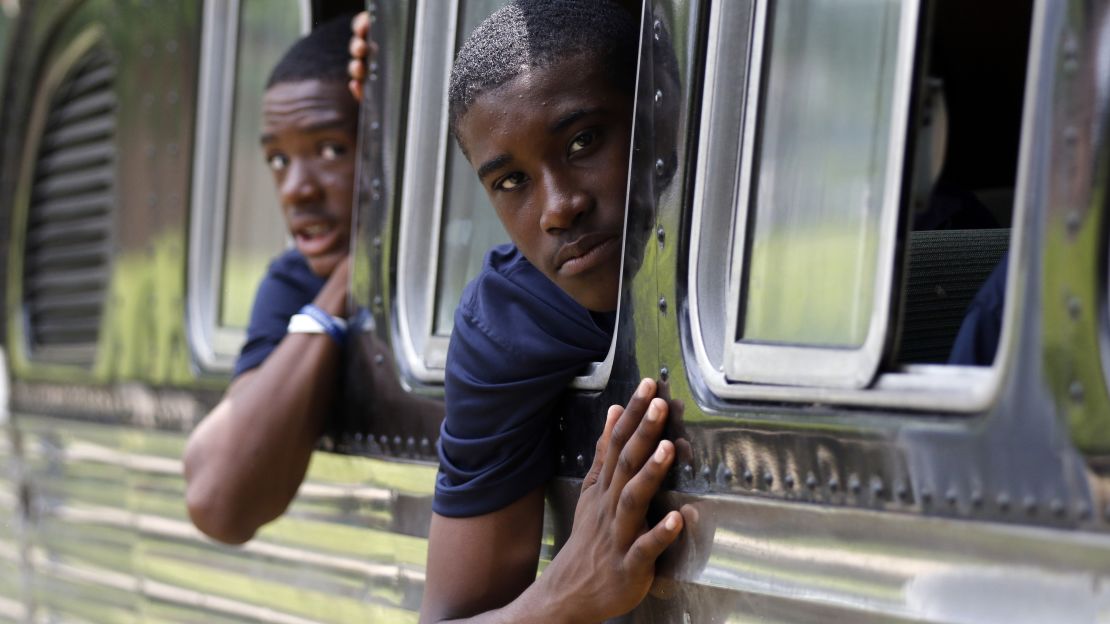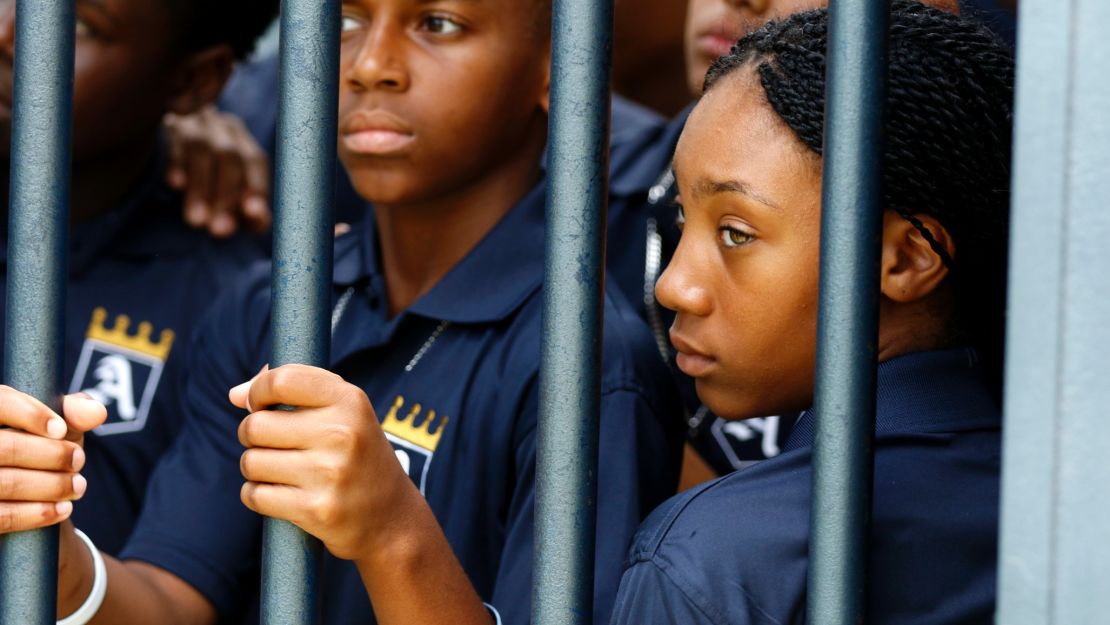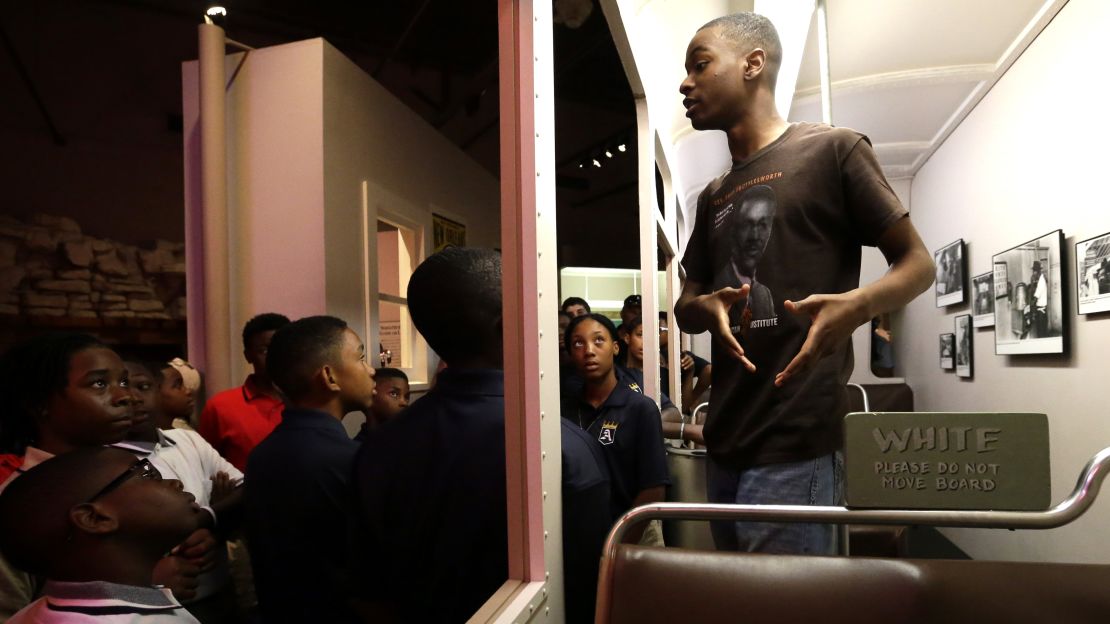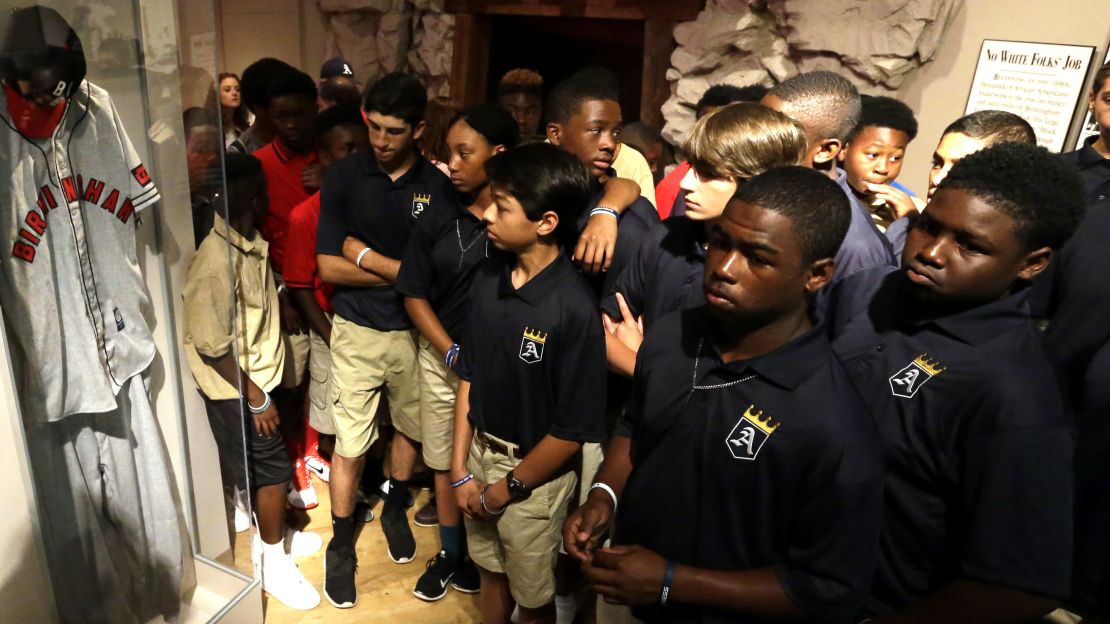Story highlights
The Anderson Monarchs, a South Philly youth baseball club, heads out on a civil rights tour
Little League phenom Mo'ne Davis and teammates meet legends and touch history
Their trip starts hours before the Charleston shooting, making the timing especially relevant
In downtown Selma, Alabama, three teenage ballplayers watch history unfold in black and white. First come the marchers over the nearby historic bridge. Then come the troopers. The bedlam. The violence.
“Oh, there’s my boy John Lewis,” says one of the kids, pointing out the image on the small museum screen of a man being clubbed.
Each hit Lewis takes feels personal to them. Just a week earlier, they’d met the civil rights leader-turned-congressman in his Washington, D.C. office.
“I would fight back,” says a second teen.
“But then they’d kill you and your family,” the first one answers, eyes wide with concern.
There’s a pause. The three of them think about this while the footage keeps rolling. Finally, the third one speaks up as he turns to walk away: “Yeah, I don’t know if I could be nonviolent.”
They and their teammates had seen the film “Selma” in preparation for their visit to this city, where events here helped change the nation. It was one of many stops in a 4,500-mile summer adventure for this young baseball team. But being here forces them to grapple with questions they can only begin to answer.
For 23 days starting in June, the Anderson Monarchs hit the road in a vintage 1947 bus for a civil rights barnstorming tour that took them from their Philadelphia home to D.C. and Atlanta before rolling into Selma and across the Deep South.
The group of 13- and 14-year-olds, most of them African-American, included athletes who went to the 2014 Little League World Series. Among them was pitching phenom Mo’ne Davis.
They set out to play some ball and, more significantly, make history real. They’d visit landmarks and shake hands with legends.

The core of this trip through time began in Atlanta, where I hopped on board and joined the team as the bus wound through five Southern states.
Their journey – which coincided with the 50th anniversary year of the march on Selma that prompted the passage of the Voting Rights Act – was the culmination of months of learning.
For half a year, Coach Steve Bandura gathered the group at their South Philly rec center for weekly movie nights. They watched historical dramas like “Roots,” “Glory” and “The Tuskegee Airmen.” They tackled documentaries including “Freedom Riders,” “4 Little Girls” and “Eyes on the Prize.”
“If you don’t understand slavery, you can’t understand the civil rights movement. And if you don’t understand the civil rights movement, you can’t understand Ferguson or Baltimore,” says Coach Steve, who’s white.
What he and his ballplayers couldn’t have imagined is how relevant their trip would become. Just hours after their bus rolled out of Philadelphia on June 17, a white gunman strolled into a Bible study at a historic Charleston, South Carolina, black church and killed nine worshippers, including the pastor. All evidence indicates that the shooter was motivated by racism, which is why he is now facing federal hate crime charges.
“It’s not ancient history. Just because laws have changed doesn’t mean people’s attitudes have changed,” says Bandura, 54. “Charleston drove that home. The first thing the kids said was, ‘It’s Birmingham all over again.’”
Under a microscope
Hook them with sports and then emphasize education and character-building: That’s Coach Steve’s way. The longtime parks and rec employee is the force behind the Philadelphia Youth Organization, which offers year-round play including baseball, basketball and soccer.
The Anderson Monarchs came out of this program 20 years ago. Boys and girls, some of whom he’s worked with since they were 3, are taught from day one that they will go to college.
Bandura’s helped kids snag scholarships long before they seek a higher education, and has even taken them in during the week so they can be closer to their schools.
The coach offers support, but he’s no pushover. The kids must respect one another and not act, as he puts it, “like horses’ behinds.” He teaches them lessons, such as: “Just because someone treats you like a king doesn’t make you a king.”
Bad language? He shuts that down with one look. Slouching or whining about the heat before they walk over the Edmund Pettus Bridge in Selma? He’s not having it. They are to walk with their shoulders back and heads held high. And they do.
“I don’t care if it’s hot,” he explains. “This is history. This is why we’re here.”
Electronics on the tour are banned. Their uniforms must be crisp and white, their shirts tucked in, their socks pulled up high. It may not be fair, but they are under a constant microscope. When they pose for pictures, he lets them know if the shot is “smiley” or “not smiley.” The roadside marker where a Freedom Rider bus was set ablaze by a white mob: Not smiley. Beside John Lewis: Smiley.

A reluctant celebrity
Not always smiley, even when fans and media want her to be, is Mo’ne Davis. The attention showered on this team member is the undeniable sideshow of this tour.
The young ballplayer grabbed headlines in 2014 after she became the first girl in Little League history to pitch a shutout in a World Series game. Soon her name and face appeared everywhere, including the cover of Sports Illustrated.
To the team, she’s just one of them. But to the public, she’s something else.
Jaws drop with recognition. Little girls squeal. Grown women scream, “We love you!” Fans charge the field and trail her every move, demanding autographs and selfies with her.
It’s well-earned, given the role model she’s become, but it’s an odd distraction from the purpose of this journey.
Mayors and city officials single her out for handshakes and photo ops. One small town offers up a proclamation, declaring June 26, 2015, “Mo’ne Ikea Davis Day.” And the media plays no small part in fueling the madness. Some outlets, when told they can’t get one-on-one interviews with her, simply walk away from a story that’s, frankly, much bigger than one girl.
The coach knows that the cameras might not be here at all if not for her, but he sometimes has a hard time hiding his frustration.
“I often feel like we’re traveling with one of the Kardashians, the way the media covers it,” Bandura says. “It’s too damn important right now, especially after Charleston. And it’s not fair to her.”
On her 14th birthday, she and her teammates were in Birmingham, Alabama, where they visited the 16th Street Baptist Church, site of a 1963 KKK bombing that killed four girls. Three of those girls were the same age as Mo’ne, and the media that swarms outside the church demand her time. The coach, who’s been a part of her life since he first spotted her in a park throwing a football with a perfect spiral at age 7, finally relents. He allows them five minutes.
What they get is hardly worthwhile.

“What struck you most?” someone asks of her visit inside.
“We learned a lot of the history behind what happened,” she says. “I really enjoyed it.”
“How’s life on the bus?”
“It’s kind of hot on it.”
“What sort of perspective do you take away considering Charleston?”
“I don’t know a lot about Charleston.”
Mo’ne knows about Charleston, of course. The team found out about the church shooting the morning after it happened. They discussed it over breakfast and with Rep. Lewis of Atlanta. She also knows about the debate swirling around the Confederate battle flag, which was celebrated by the gunman.
In moments like this one in Birmingham, though, she appears a reluctant celebrity. She’s a child who can’t be expected to wax poetic on civil rights issues.
When she’s around her teammates, she lights up, is engaged and smiles easily. In front of this sea of cameras, her face falls and she looks miserable.
I ask her later if she misses going unrecognized. She says she only does after games, when she’s hot, tired and mobbed by crowds. The coaches often step in to cut people off. Her teammates, who are like brothers to her, say they sometimes surround her like Secret Service.
The line between childhood and maturity
Before Birmingham, they walk through the Atlanta home where the Rev. Martin Luther King Jr. was born and raised. Later, after Little Rock, Arkansas, they gaze out at the balcony of the Lorraine Motel in Memphis where he took a bullet and his last breath.
In various museums, they stare down displays of Ku Klux Klansmen, take in images of lynchings and grimace in front of drinking fountains marked “colored.”
They visit the Jackson, Mississippi, house where NAACP leader Medgar Evers lived and died, assassinated in his driveway hours after President John F. Kennedy proposed the Civil Rights Act.
Along the way, they receive living testimonies.
A Freedom Rider points to his mugshot, taken when he was 19. A man who helped desegregate lunch counters and trained in nonviolence alongside John Lewis shares the last words MLK said to him, five hours before he was killed. A daughter of a civil rights attorney shares tales of growing up under Jim Crow laws and remembers the gun shots that blew through her family’s home windows. The younger sister of a girl killed in the 1963 Birmingham church bombing talks about honoring the past.
The content, no doubt, is heavy. Outside the Birmingham Civil Rights Institute, one boy breaks down in tears. His teammates reach out to comfort him, as does a father traveling with the group. The Anderson Monarchs are a family, and they’re in this together.

Playing baseball, which they do often during this tour, lets them take a break from deep thinking and feeling – while trouncing local teams. In the week I was with the team, the scoreboards told the tale: 18-1. 20-2. 16-5.
There are also plenty of moments when they are just kids being kids. Without electronics, they play Uno and Battleship on the bus while chomping on Big League Chew bubblegum. Over pizza in a small-town restaurant, they sway and sing along to John Legend’s “All of Me.” Whenever they hear Silentó’s “Watch Me (Whip/Nae Nae),” a song that’s spawned a viral dance sensation, they jump up to show off their moves.
Coach John Bromley catches one boy preparing to iron his shorts while wearing them. The kids pull their shirts over their noses and scream “Ewwww!” as the bus rolls past farms that reek of manure. Overheard from the back of the bus, amid laughter: “I’ll sit on your head and fart on your head if you don’t stop playing with me!”
But even as they joke around over a free hotel breakfast, laughing about the “great flood” in one of their rooms the night before, they are wired to pick up what’s happening in the world around them. The television in the dining area reports the morning news.
Outfielder Myles Eaddy, who refers to President Barack Obama as “Obeezy,” pumps his fist in the air and cheers, “Woohoo!” when he spots footage of an activist climbing down a South Carolina statehouse flagpole with the Confederate flag.
“She got arrested, but I like her way of thinking,” says second baseman Jahli Hendricks.
Minutes later, third baseman Jack Rice sits riveted watching reports about the Supreme Court decision – handed down the day before – that legalized same-sex marriages across the country. Jack says he lives in a neighborhood with a large gay community.
“I think it’s good whenever I see a couple walking down the street,” he says.
This historic news, and learning about it on this trip, means something to him.
“It’s almost like another civil rights movement,” he says.
Later in the day, as we drive through an underpass, a spray-painted message on a concrete wall catches my eye. In large green letters it says, “No to gay marriage,” and underneath that, “Kill.”
I turn around to see if Jack, who’s seated behind me, saw it, too. I’m sort of grateful he’s looking the other way.

What others worked for
At Atlanta’s Turner Field, they meet baseball great Hank Aaron. And in Birmingham, players from the former Negro Leagues come out to have lunch with the Monarchs and watch them take on a local team.
The kids step onto the hallowed ground that is Rickwood Field, the oldest ballpark in America. Babe Ruth and Ty Cobb graced this diamond, as did Willie Mays – who first made his mark as a teenager when he began playing here for the Birmingham Black Barons in 1948.
That was one year after Jackie Robinson broke the color barrier in Major League Baseball – and the same year the Monarchs’ vintage bus first hit the road.
The 1947 Flxible Clipper garners gawks at gas stations. Drivers speed up from behind to snap pictures and get closer looks. As the bus passes one city sidewalk, a parking attendant screams, “One of a kind!”
As far as Tom Murphy knows, it is the only one of its kind. Some have been turned into RVs, the team’s mechanic says, but as a working bus, this is it. Murphy, who deals in auto parts, found it in 1997. It had been sitting in a Connecticut barn for 24 years before he came along and made it run again.
Ernest Fann, 72, sits up in the stands at Rickwood Field and says the bus is not so different from the sort he rode in when he joined the Negro Leagues in 1962, playing with the Raleigh Tigers right before the leagues were phased out.
He and his teammates ate and slept in a bus like this one, barred by Jim Crow laws from being able to check into hotels. They stopped at creeks to wash their clothes, letting their laundry dry from bus windows. They lived on a big stick of baloney – “schoolboy steak,” he calls it – and a couple loaves of bread. Fann made $5 a day when he played, and that could be for as many as three games a day.
By the time he joined the Negro Leagues, he says the players were united in what their message was to the world.
“It wasn’t about us,” he says. “It was about trying to open up the door for the kids.”
He went on to play in the minor leagues for a bit before two knee surgeries did him in. But he’s happy to be where he is now. He looks at the kids on the field, what they’ve achieved and the opportunities available to them, and can only smile.
“It means a lot,” he says, “because this is what we worked for.”

‘The cake to go with the icing’
What will they work for? How can they make a difference and take the baton from those who walked and played before them? In what ways will they serve as an example to others? If they see a kid being bullied at school or online, will they speak up?
These sorts of questions are posed to the Monarchs time and again, and perhaps no one drives home the message more during their swing through the South than a woman who stands before them a stranger.
Sybil Jordan Hampton isn’t etched in history books or honored in films or museums. When she tells people she helped integrate Little Rock Central High School, she says they usually stop listening when they learn she wasn’t one of the “Little Rock Nine.”
Not today.
These students lean forward to take in her every word. Hampton, 71, tells them that while the world watched the “Little Rock Nine” enter Central High in 1957 with a military escort amid screaming protesters, the story continued long after the cameras went away. That’s when her journey began.
After a year of struggles during that first attempt at integration, the governor of Arkansas dug in his heels against the federal order to end segregation. He signed a bill allowing Little Rock to close its public high schools. That next year became known as the “lost year.” When the schools reopened in 1959, Hampton was one of just five black students to enter Central High. And she was the only one in her graduating class of 544 students.
The city took an economic hit in ’57, so the mandate in ‘59 was to avoid drama and further media attention. As a result, there weren’t loud protests. Instead, not one white student spoke to Hampton in her three years at the school.
When she walked down the halls, crowds parted as if she had the plague. She remembers when a football player kicked her bandaged knee in a hallway and no one stepped forward to help her. But she also remembers when a student spit in her face, and the assistant vice principal and secretary finally wrapped their arms around her.
“You have to be open. There may be a moment that touches hearts,” she says. “We’re seeing one of those moments right now, right?”
“Yes,” the students respond in unison. Like her, their minds turn to Charleston and the outpouring of love and support toward victims’ families, survivors of the church massacre and the church itself.
She tells them about her commitment to forgiveness. She shares lessons her parents taught her about those who made her feel worthless.
“My mother and father always said, ‘Those people, Sybil, don’t know you. You are a symbol of what they hate. It’s not about you. You are a symbol. Because, baby, if they could really know you, they’d love you.’ ”
Doing well has been her best revenge, says Hampton, a lifelong educator who holds a doctorate in education from Columbia University. She speaks often to groups.
When black teens talk to her about how angry they are, she always has an answer ready: “If I am not an ax murderess, what do you have to be angry about?”
She looks out at the group, most of whom, like her, haven’t made headlines, inspired movies or drawn media attention. But, like her, they can make a difference in this world.
“Not everyone here is going to be a star,” she says, “but everyone is important. We all matter.”
Her talk brings applause, and the students walk up to not just thank her but hug her.
“This is the cake to go with the icing,” says Coach Steve. “This is what it’s really about.”
And as the kids gather around Hampton to take a picture with her, he tells them this one is smiley. Most definitely smiley.



